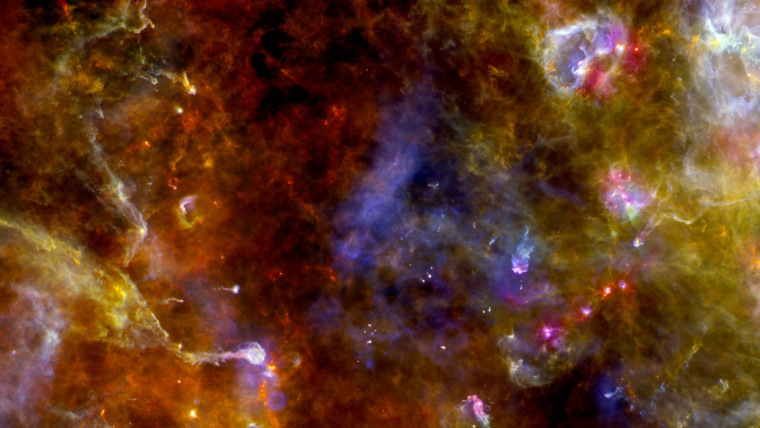Sep 23 2020
Interstellar medium refers to the matter between the stars in a galaxy. It contains gas as well as a significant amount of dust. At a certain period of time, planets and stars evolved in such an environment, because the dust particles can cluster together and combine into celestial bodies.
 Clouds of interstellar dust and gas, here in the region “Cygnus-X” in the Swan constellation. Image Credit: ESA/PACS/SPIRE.
Clouds of interstellar dust and gas, here in the region “Cygnus-X” in the Swan constellation. Image Credit: ESA/PACS/SPIRE.
Significant chemical processes also occur on these particles, from which intricate organic—perhaps even prebiotic—molecules develop. However, water is necessary to allow these processes to occur. In specifically cold cosmic surroundings, water exists in the form of ice. But so far, the relationship between dust and ice in these regions of space was vague.
Now, a team of researchers from Friedrich Schiller University Jena and the Max Planck Institute for Astronomy has demonstrated that the ice and the dust particles are clumped together. The researchers have described their findings in the latest issue of the Nature Astronomy, a research journal.
Better Modeling of Physico-Chemical Processes in Space
Until now, we didn’t know whether ice is physically separated from the dust or mixed with individual dust moieties. We compared the spectra of laboratory-made silicates, water ice and their mixtures with astronomical spectra of protostellar envelopes and protoplanetary disks. We established that the spectra are congruent if silicate dust and water ice are mixed in these environments.
Dr Alexey Potapov, University of Jena
Astrophysicists can obtain critical information from this data. “We need to understand different physical conditions in different astronomical environments, in order to improve the modelling of physico-chemical processes in space,” added Dr Potapov.
This outcome would allow scientists to better estimate the volume of material and to make more precise statements about the temperatures in various regions of the circumstellar and interstellar media.
Water Trapped in Dust
Through comparisons and experiments, the team from the University of Jena also noticed what exactly takes place with water when the temperatures rise up and the ice exits the solid body to which it is attached and passes into the gas phase at approximately 180 K (–93 °C).
Some water molecules are so strongly bound to the silicate that they remain on the surface or inside dust particles. We suspect that such ‘trapped water’ also exists on or in dust particles in space. At least that is what is suggested by the comparison between the spectra obtained from the laboratory experiments and those in what is called the diffuse interstellar medium. We found clear indications that trapped water molecules exist there.
Dr Alexey Potapov, University of Jena
The presence of such solid-state water indicates that complex molecules might also exist on the dust particles in the diffuse interstellar medium. If water exists on such particles, scientists may be closer to realizing complex organic molecules, for instance.
This is because the dust particles typically contain carbon, among other things, which along with water and under the effect of ultraviolet radiation, like those detected in the environment, supports the development of methanol, for instance.
Scientists have already observed organic compounds in these regions of the interstellar medium, but to date, it was not known where they came from.
The existence of solid-state water can also offer answers to questions regarding another element—although scientists are aware of the amount of oxygen in the interstellar medium, they formerly had no data about where exactly around a third of it is present. The results of the new study indicate that the solid-state water in silicates is a concealed reservoir of oxygen.
Does Solid-State Water Help in the Formation of Planets?
Furthermore, the “trapped water” can help understand the way dust builds up, as it could support smaller particles to stick together to form bigger particles. An effect like this may even work on the formation of planets.
If we succeed in proving that ‘trapped water’ existed—or could exist—in building blocks of the Earth, there might possibly even be new answers to the question of how water came to Earth.
Dr Alexey Potapov, University of Jena
But nevertheless, these are just suppositions that the Jena team wants to track in the days to come.
Journal Reference
Potapov, A., et al. (2020) Dust/ice mixing in cold regions and solid-state water in the diffuse interstellar medium. Nature Astronomy. doi.org/10.1038/s41550-020-01214-x.